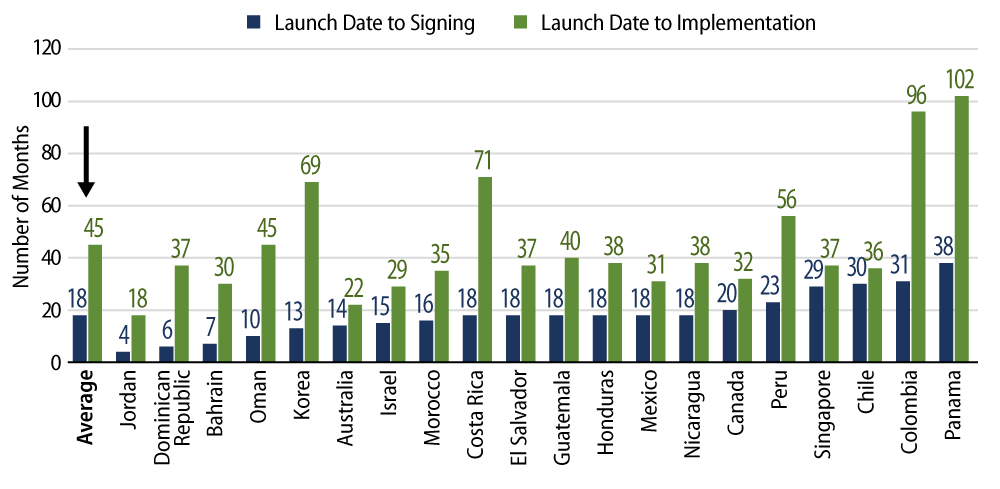The US and China announced a 90-day pause in their ongoing tariff dispute today. The US reduced tariffs on Chinese imports from 145% to 30%, and China lowered tariffs on US imports from 125% to 10%. Markets responded positively and interpreted this development as a step back from the brink of a global economic slowdown. However, it is important to underscore that these are provisional trade deals rather than legally binding agreements—a critical distinction. Historically, the journey from a trade deal announcement to formal signing can take approximately 18 months, with full implementation often requiring nearly four years.1 For instance, in 2018, a similar US-China truce quickly unraveled, resulting in an additional 18 months of negotiations before the “Phase One” agreement was ultimately signed in January 2020.2

While this latest truce represents a constructive de-escalation, significant questions remain: what is the future direction of US trade policy? Will US Treasuries (USTs) and the dollar maintain their safe-haven status? Are we approaching a fundamental shift in global capital flows? In this discussion, we aim to look beyond short-term developments and examine the deeper structural forces that will ultimately shape market outcomes and fixed-income valuations.
I. US Trade Policy: Uncertainty, Risks and Economic Fallout
There is little doubt that US trade policy has become a major source of confusion and uncertainty for consumers, businesses and investors alike. Once a steadfast proponent of free trade, the US has shifted decisively toward protectionism, most notably through the widespread imposition of tariffs. This pivot is not easily reversed, and its ramifications extend well beyond headline trade statistics. Prior to the introduction of tariffs, the US benefited from open markets and robust supply chains, reinforcing its position of strength in global commerce. The advent of tariffs has not only raised costs but also disrupted global trade flows, introducing a heightened level of unpredictability into business planning and consumer sentiment.
Although the risk of recession has somewhat diminished following recent developments, it remains a persistent concern—particularly for the Federal Reserve (Fed), which continues to grapple with uncertainty around inflation. The Fed is hesitant to cut rates without clear evidence of stress among households and businesses. Early indications of a cooling labor market may help to contain inflationary pressures, but the risk remains that inflation expectations could become unanchored, especially if trade tensions re-escalate or supply shocks intensify.
Signs of strain are already emerging across the economy: canceled orders, ships idling offshore and bankruptcies among established retailers are no longer hypothetical risks but observable realities.3 The timing and nature of policy decisions by the Trump administration are therefore critical, as both best- and worst-case scenarios remain plausible depending on the trajectory of trade negotiations and broader global dynamics. Market anxiety is further compounded by the fact that the scope and duration of tariffs are largely at the discretion of President Trump, and Congress is currently exercising only limited oversight. As a result, meaningful policy shifts are unlikely in the absence of significant political change, such as a shift in control of the House of Representatives in the 2026 midterm elections.
II. Safe-Haven Status: USTs and the Dollar Under Scrutiny
The debate over the safe-haven status of USTs and the US dollar has also intensified. Recent volatility in these assets has reignited questions about whether they are at risk of losing their privileged status amid rising US debt, confrontational trade policy and heightened global scrutiny. US credit risk is increasingly in the spotlight, with some fearing a UST buyer’s strike and questioning the sustainability of US debt.4 Despite these concerns, foreign demand for both long- and short-dated USTs remains healthy and diversified. Most notably, countries such as China have made little actual reduction in their US asset holdings.5 Moreover, demand for shorter-dated USTs tends to increase during recession periods. Overall, the US retains unique advantages in managing its debt, including the ability to use inflation, financial repression, buybacks and quantitative easing. Its unmatched capacity to provide deep, liquid markets stands out, especially when compared to other government bond markets such as those of Germany, the UK, China and Japan.6
It is worth highlighting that the recent volatility in the dollar has occurred against a backdrop of peak valuations and elevated levels of foreign ownership of US assets.7 Although the dollar could face further downward pressure as global investors seek greater diversification, concerns about its imminent demise are exaggerated. As we have previously discussed, there are currently no credible alternatives to the dollar in the short or medium term. The euro remains hampered by a lack of political and fiscal integration, the yen suffers from limited global liquidity and transactional use, and the yuan is not fully convertible. Other potential substitutes—such as gold, commodities and cryptocurrencies—are constrained by their own issues, including price volatility, storage challenges and regulatory uncertainty.
III. Global Capital Flows: Transformation and Market Implications
The shifting landscape of global capital flows has also become a critical focus for markets. For decades, the US has been the primary destination for the world’s current account surpluses, with export-driven wealth from abroad consistently reinvested in US assets.8 This dynamic has resulted in a substantial buildup of US liabilities to foreign investors. Although speculation is growing over whether capital is meaningfully rotating away from US assets toward Europe, Asia and select emerging market (EM) economies, US equities continue to hold a commanding position in the global investment landscape—both in terms of scale and market influence.9 Foreign investors have also maintained a strong appetite for US corporate credit, attracted by compelling yields and strong fundamentals. Although uncertainty surrounding tariffs has begun to weigh on both the demand and supply sides of US credit markets, credit spreads and default rates remain stable for now, underpinned by resilient sector fundamentals and supportive technical conditions.
The combined effects of tariff pressures and intensified competition among OPEC+ members for market share have driven EM oil prices lower, placing strain on the bonds of Latin American energy producers and select frontier market issuers.10 Nevertheless, EM currencies—particularly those in Latin America—have been supported by elevated real interest rates and a weaker US dollar, and stand to benefit further from easing trade tensions between the US and China. Coupled with improving technical conditions in local currency debt markets relative to their USD-denominated counterparts, these factors are likely to bolster investor demand and drive increased flows into local EM debt.
Ultimately, the direction of global capital flows will be shaped by the outlook for US debt. Rising inflation, expansive fiscal policy, and ongoing uncertainty surrounding the Fed’s actions are driving term premiums higher and fueling greater volatility in US rates. Market instability remains hostage to conflicting policy signals from President Trump and key cabinet members, stalled progress on deficit reduction despite recent DOGE-related spending cuts and persistent challenges to the Fed’s independence—all of which heighten the risk of increased US borrowing costs.11 Moreover, the likelihood is growing that forthcoming economic data will expose mounting pressures and potentially weigh on risk assets.
Currently, markets remain optimistic about prospects for additional trade deals and the continuation of Trump policies that support lower taxes and greater deregulation. However, much of this optimism is already reflected in asset prices, and a sustained rally would require a meaningful acceleration in economic growth. A more cautious approach is warranted in our view given the administration’s limited response to emerging economic headwinds—raising the risk of escalating political costs. With Trump’s approval ratings under pressure on multiple fronts and the 2026 midterm elections on the horizon, we believe that political risk is set to become another important driver of market sentiment and outcomes.12
In Closing
The latest US-China trade deal is a positive step, but the whiplash of US trade policy has already unleashed a wave of uncertainty across the global economy—fueling real risks of recession (though currently muted), elevated inflation and supply-chain upheaval. Yet, even amid these mounting headwinds, we believe USTs and the dollar continue to stand unrivaled as the world’s safe-haven assets, with no credible challengers on the horizon. Looking forward, shifting global capital flows, escalating concerns over US debt and rising political risk will be decisive forces shaping market direction. Should upcoming trade negotiations disappoint, markets could face another sharp reset.
ENDNOTES
1. Freund, C. (21 Jul 16), “How Long Does It Take to Conclude a Trade Agreement With the US?”, PIIE
2. Bloomberg (12 May 25), “US China to Slash Tariffs During 90-Day Reprieve for Talks”
3. Port of Los Angeles data (20 Apr – 10 May 25); Toy Association Member Survey (Apr 25)
4. Financial Times (8 Apr 25), “US Treasuries Sell-Off Deepens as ‘Safe Haven’ Status Challenged”
5. China’s State Administration of Foreign Exchange, Federal Reserve Board (Dec 24), “Total US Treasuries Held by China, Belgium and Luxembourg Have Remained Stable”
6. Bloomberg (8 Apr 25), “There Isn’t a Practical Alternative to US Treasuries”
7. Bloomberg (28 Apr 25), “US Assets Face Foreign ‘Buyers Strike,’ Deutsche Bank Says”
8. HSBC Global Research (3 Mar 25), “Credit Corner: An Inconvenient Truth”
9. Goldman Sachs Global Investment Research, 24
10. Reuters (14 Apr 25), “Oil Price Drop Turns up Heat on Emerging Market Crude Exporters”
11. Reuters (24 Apr 25), “100 Days of DOGE: Lots of Chaos, Not So Much Efficiency”
12. Polling News (8 May 25), “Trump Approval on Key Issues”

